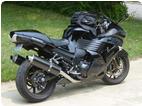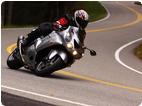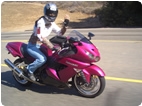Here's an email exchange I had a few days ago with Nick Ienatsch of FasterSafer.com and the Yamaha Champions Riding School. It's a question I've had in my mind for several years, and haven't had a chance to ask anyone "in the know" until now. I don't think Nick would mind if I posted it here.
My question:
One of the things that I've wondered about over the past couple of years riding track days is this: How can you find the edge (maximum lean angle that leaves you on your wheels) without going past it? I asked a racer friend this question and his answer was: "You can't". I'm not sure I buy that.
I'm not interested in ending up on the ground, but I'd very much like to know if there is a way I can get a sense of how far I can lean the bike over in a corner. While the answer to the question is probably "It depends...", I wonder if there is a process that one can go through (given an understanding of the 100 points of traction, trail braking to the slowest point in the corner, super smooth application of brakes and throttle, race tires warmed up on a dry track on a warm day) to seek out the maximum safe lean angle?
And I wouldn't be surprised if the answer to the question is different:
- when you are trail braking,
- when you are in a corner at maintenance throttle, and
- when you are accelerating out of a corner.
Never having been on the ground, I wonder if, when you exceed the maximum lean angle that your bike/tires can handle, does it go real fast (too quickly to save), or can you get close to the maximum lean angle and get some feedback from the bike that tells you you can't go any further (and lets you save it). If the latter, what does this feedback feel like?
You guys have all been there, but I haven't.
Nick's response:
Your question is what we all would like to know: Where's the limit? Here are a few thoughts, all dealing with warm tires because cold tires lose grip suddenly and completely. Body Position: When your body position is "right"...like Stoner, Hayden, Rossi, etc...your knee will touch before your tires lose grip. The knee becomes the lean angle gauge and you know when it starts to touch down, you are approaching the edge of the tire. We use this as a gauge for our students desiring to run more lean angle: Is your knee touching? If not, and your body is "right", you can run more speed into the corner and carry more lean angle.
And then it becomes a matter of how hard/much your knee is touching. In our three-day schools, we've begun to run the students back and forth through a single corner, allowing them to increase speed in this controlled environment to get a feel for lean angle. We will us a Sharpy marker pen to draw a line up the tread of the rear tire and encourage them to wear this line off, step by step. Our R6s will use the entire tread of the rear tire, but not the front. You will notice the racers touching their knees down at turn-in, and then even tucking their knees up against the side of the fairing as they use maximum lean angle. Watch AMA 600 Supersport because they are on average race tires, nothing special. What they can do, we can do.
You ask about feedback at the limit. Yes, the tire will do its best to warn you of traction loss before it lets go... The front will go slightly light and loose in your hands as it begins to tuck, the rear will spin slightly and step out, squirm. This gets us right back to how you add throttle, brake and LEAN ANGLE points... if you're aggressive with any addition of those points when you're near the limit, it will be gone quite quickly. That's why we run students back and forth through a single corner and ask for a little additional speed each run. No big steps. It's also why we insist on linear control inputs no matter how fast our students go... near the limit, everything counts.
-bg
* Last updated by: bgordon on 2/4/2012 @ 9:19 PM *

























